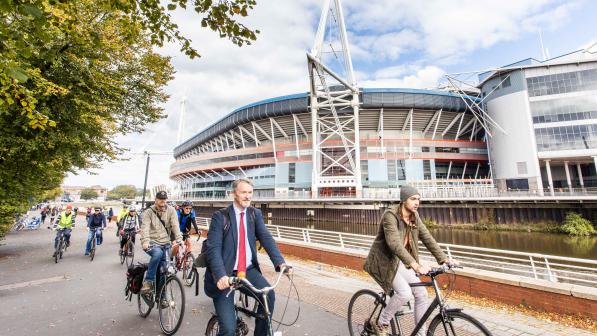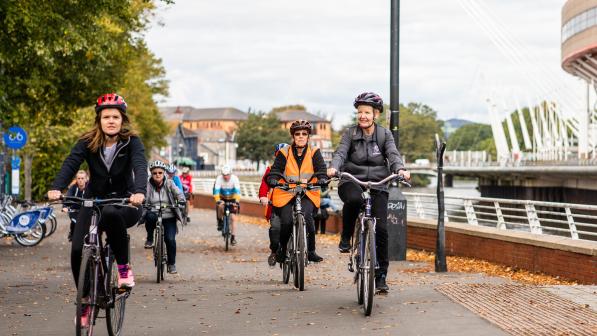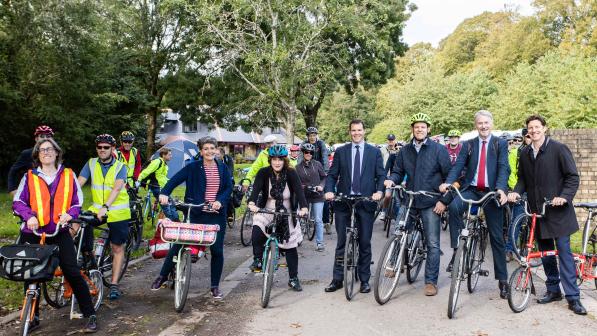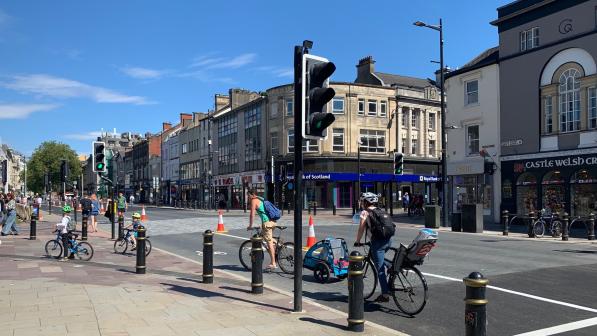Wales leads again with radical approach to new road building

Politicians are often criticised for ducking difficult decisions, kicking them into the long grass because they fear they’ll be kicked for being honest about what needs to change. And politicians across the UK have been ducking difficult decisions on building ever more new roads for decades.
But not yesterday. Not in Wales. Not Lee Waters, the Deputy Minister for Climate Change. At last a government in the UK has fully accepted what the evidence has shown for decades: you can’t just build your way out of congestion.
For 30 years across the UK, as the number of motor vehicles on the roads increased, the instinctive response from various governments and agencies has been to build more roads, or to add another lane in the forlorn hope that one more lane will fix congestion.
But it hasn’t, it doesn’t, and we’ve known about the concept of induced demand since at least the 1960s.
When we build new roads, we make it easier for people to make more car journeys, so we get more motor traffic and the congestion doesn’t disappear - it just returns.
As American urbanist Lewis Mumford put it, “Building more roads to prevent congestion is like a fat man loosening his belt to prevent obesity”.
But in Wales the belt isn’t going to be continually loosened, because the Welsh Government now has four tests which it will apply when considering future road building, namely whether the scheme will:
- Support modal shift (more journeys walked, cycled or using public transport) and reduce carbon emissions.
- Improve safety through small-scale changes.
- Adapt to the impacts of climate change.
- Provide access and connectivity to jobs and centres of economic activity in a way that supports modal shift.
Increasing road capacity, for so long the stated goal of so many schemes, will no longer be a justification in itself for building a new road; minimising carbon emissions, both from construction and use, will be a key focus.
The minister’s announcement yesterday is definitely a groundbreaking moment in Wales, but should be for the rest of the UK as well.
It heralds a fundamental shift in approach to roads investment which other governments in the UK simply can’t ignore. However, nobody can really say they weren’t warned this was coming.
Back in September 2021, Welsh ministers commissioned an independent Roads Review panel to ensure that proposed roads investment in Wales aligned with Welsh Government commitments on climate change (Net Zero) and wellbeing, and those set out in Llwybr Newydd, the new Welsh Transport Strategy which prioritises active travel and public transport.
The panel was also tasked with developing criteria to identify appropriate circumstances for expenditure in the future on roads, and to use these criteria to recommend which projects already in the pipeline should be supported, modified or have support withdrawn.
While waiting for the results, 55 proposed road projects were paused.
The panel, chaired by Dr Lynn Sloman MBE, issued an initial report in February 2022. We now have the panel's final report, along with the Welsh Government’s response and their National Transport Delivery Plan (NDTP), which outlines how the Welsh Government intends to deliver Llwbr Newydd and align transport with their transition plan to a decarbonised economy.
But there’ll still be criticism of the roads review recommendations and the Government’s response. This is because some planned road schemes won’t proceed either at all or as originally envisaged, with people arguing that the proposed bypass where they live is the key scheme which should be funded. However, the tests the panel have come up with do make those arguments easier to deal with and decision-making more transparent.
Historically, some of the conversations about road building have been too binary, with those convinced you can build your way out of congestion on one side and others seemingly opposed to all new road building on the other. Many in the latter camp have told me in the past that they weren’t opposed to all new road building, but have then been unable to give me an example of any new road scheme they would support, or the criteria which should be taken into account to make that decision.
These recommendations cut through that - because the Welsh Government aren’t saying no to all new roads. Rather, they’re setting out a new set of criteria for determining which should proceed, reflecting the urgent need to reduce carbon emissions from transport (15% of total emissions in Wales).
Both in Wales and across the UK, those emissions have hardly reduced in the last 30 years, even with car engines generally getting cleaner over time. This is because the thinking everywhere has been to just keep building to put more cars on the road, instead of investing in the alternatives, namely public transport and of course, for shorter journeys or part of a longer journey linked to public transport, walking and cycling.
There’s no doubt this decision is going to be controversial for some. But, amidst a few hysterical reactions, a reasonable question to ask involves the alternatives, particularly in rural areas, if new roads aren’t built.
We want more people to use public transport, walk or cycle for a multitude of reasons, and moving towards that can involve both carrots to encourage and enable, and sticks to make the alternative - driving - less attractive.
But, if one of those sticks to reduce demand for motor traffic is to stop building new roads, and stop increasing roads capacity, how does that help secure modal shift if there isn’t a viable public transport network in those rural areas, and no safe infrastructure making active travel a convenient, safe and attractive option?
That’s the dilemma, of course.
If we don’t introduce sticks to reduce the demand for motor traffic until we have the perfect alternatives, we’ll be waiting for ever. But if those sticks are being introduced, whether by restrictions on road building, congestion or road user charging, or increases in fuel duty, the reality is that people will have to see concurrent major investment and improvement in both public transport and active travel infrastructure.
And that’s why I’m writing about road building in an article for Cycling UK. Sustainable and active travel advocates can’t simply campaign, push and lobby for more investment as though the resource is infinite.
We have to be honest and really clear. There has to be a major reallocation of our spending priorities, and if governments stop wasting money on ludicrously expensive road schemes which don’t reduce congestion in the long-term, increase carbon emissions from transport and perpetuate a failed policy, then they’ll have all the resource and more they need to invest in world-class public transport systems and active travel networks.
So, no surprises, at Cycling UK, we think this decision by the Welsh Government is a game-changer. But they do need to ensure that money saved by not building those new roads is spent on the alternatives.
Finally, in Wales, we have an evidence-based approach to future road building to make sure that schemes are only progressed if they meet sensible tests, including on carbon emissions, focusing on getting more people using public transport, walking and cycling.
The question those who disagree with this approach should answer is this: what’s your alternative for reducing carbon emissions from transport and securing modal shift?
After all, if we're serious about meeting the climate crisis challenge, we need to become a society that supports multi-modal transport and, if we want people to walk, wheel or cycle alongside using public transport, we need continued investment in improving infrastructure that supports that.




